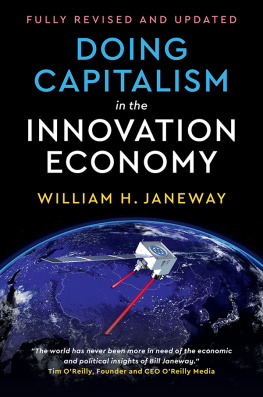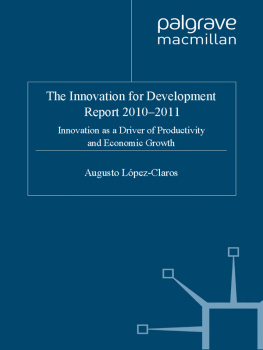State of Innovation
The U.S. Governments Role in Technology Development
edited by
Fred Block and Matthew R. Keller
First published 2011 by Paradigm Publishers
Published 2016 by Routledge
2 Park Square, Milton Park, Abingdon, Oxon OX14 4RN
711 Third Avenue, New York, NY 10017, USA
Routledge is an imprint of the Taylor & Francis Group, an informa business
Copyright 2011, Taylor & Francis.
All rights reserved. No part of this book may be reprinted or reproduced or utilised in any form or by any electronic, mechanical, or other means, now known or hereafter invented, including photocopying and recording, or in any information storage or retrieval system, without permission in writing from the publishers.
Notice:
Product or corporate names may be trademarks or registered trademarks, and are used only for identification and explanation without intent to infringe.
Library of Congress Cataloging-in-Publication Data
State of Innovation: the U.S. government's role in technology development / edited by Fred Block and Matthew R. Keller
p. cm.
Includes bibliographical references and index.
ISBN 978-1-59451-823-2 (hardcover: alk. paper)
ISBN 978-1-59451-824-9 (paperback: alk. paper)
1. Technological innovationsGovernment policyUnited States. 2. Technological innovationsEconomic aspectsUnited States. 3. Techology and stateUnited States.
4. Industrial policyUnited States. I. Block, Fred L. II. Keller, Matthew R.
HC110.T4S73 2010
338'.0640973dc22
2010014738
Designed and Typeset by Straight Creek Bookmakers.
ISBN 13: 978-1-59451-823-2 (hbk)
ISBN 13: 978-1-59451-824-9 (pbk)
Contents
| by Peter Evans |
| Fred Block |
|
The Military's Hidden Hand: Examining the Dual-Use Origins
of Biotechnology in the American Context, 19691972 |
| Shelley L. Hurt |
| Steven P Vallas, Daniel Lee Kleinman, and Dina Biscotti |
To Hide or Not to Hide? The Advanced Technology Program
and the Future of U.S. Civilian Technology Policy |
| Marian Negoita |
Green Capitalists in a Purple State: Sandia National Laboratories
and the Renewable Energy Industry in New Mexico |
| Andrew Schrank |
| Matthew R. Keller |
DARPA Does Moore's Law: The Case of DARPA and
Optoelectronic Interconnects |
| Erica Fuchs |
| A | Evaluating Impact |
Where Do Innovations Come From? Transformations
in the U.S. Economy, 19702006 |
| Fred Block and Matthew R. Keller |
| Chris P. Knight |
| B | The U.S. Case in Global Perspective |
From Developmental Network State to Market Managerialism
in Ireland |
| Sean 0 Riain |
China's (Not So Hidden) Developmental State:
Becoming a Leading Nanotechnology Innovator
in the Twenty-First Century |
| Richard P. Appelbaum, Rachel Parker, Cong Cao, and Gary Gereffi |
| C | Toward an Innovation Society |
| John A. Alic |
The Paradox of the Weak State Revisited:
Industrial Policy, Network Governance,
and Political Decentralization |
| Josh Whitford and Andrew Schrank |
Avoiding Network Failure: The Case of the National
Nanotechnology Initiative |
| Christopher Newfield |
FOREWORD
State of Innovation
The U.S. Governments Role in Technology Development
Peter Evans
What makes the appearance of State of Innovation an important eventboth for future theorizing on the dynamics of economic growth and for progress in the direction of more effective policies? Anyone with even a cursory acquaintance with U.S. history is aware of the U.S. government's central role in fostering the country's exceptional economic growth, from Hamiltonian tariff policy to canals to agricultural research. Likewise, no one familiar with the history of contemporary innovation would gainsay the central role of government initiatives from DARPA to the National Nanotechnology Initiative.
Of course government agencies and government support for private actors play an absolutely essential role in fostering innovation. Only someone trapped in ideological amber would expect otherwise. Private entrepreneurship is also a central part of the story. Who would expect otherwise in the country that epitomized late-twentieth-century capitalism? The scholars who put together this book are not interested in rehearsing stale state-versus-market debates built on nineteenth-century theorizing. They are interested in figuring out how to realize the twenty-first-century potential for innovations that will enable human capabilities to flourish and prevent the planet from turning into a hostile biosphere.
This is an important book precisely because it is not an argument for a bigger government role. It is an argument for looking at how innovation is actually organized and how it might be organized better. It helps us to understand how networks, organizations, and institutional arrangements worked across the conventional public-private divide to produce an impressive array of innovations in late-twentieth-century America. Starting with careful histories of what actually worked, it goes on to derive general analytical lessons that will help guide future experiments in building innovation-fostering institutional structures.
The critical question is how to create positive synergies between public support and private initiative, between government action and markets, between networks and corporate organizations to produce the innovations we need and want. The book attacks this question in two ways. First it offers concrete histories of how innovations happened. Fresh, well-documented narratives give readers a chance to reconsider the usefulness of conventional prior accounts. Second, it offers new analytic frames, new conceptualizations, and new propositions regarding which institutional designs work and why.
The history is the crucial foundation. The book's contributors chronicle systematically and thoroughly a range of projects and policy arenas in which diversely structured synergies have emerged among government agencies, businesses, and scientists and engineers. One of the revelations of the book is that precisely in the period since Ronald Reagan's election in 1980, when the political rhetoric regarding growth and innovation was almost purely "free market," the U.S. government was carefully and quietly developing new capacity to carry out effective innovation policies in collaboration with the private sector. As Block and Keller show in their chapter, in 2006, seventy-seven out of eighty-eight award-winning innovations benefited from some federal support. Similarly, in their chapter, Vallas, Kleinman, and Biscotti provide evidence that most of the blockbuster new pharmaceuticals developed by U.S. firms over the last twenty years drew heavily on governmental support.
If the book offered only historical narrative it would be a signal contribution, but the same chapters also make theoretical contributions. It is the combination of theory and history that makes the book so exceptionally valuable. State of Innovation digs further to analyze the mechanisms by which these government innovation policies in the United Statesand in several comparative caseshave been able to achieve consistent results.
The argument is that these programs have adapted to a new era of networked production in which both innovation and production increasingly take place in complex collaborations among different firms and, often, nonprofit entities. As Whitford and Schrank put it, "the activities most likely to be targeted by industrial policy are increasingly governed by decentralized production networks rather than competitive markets or vertically integrated corporations." Nor are decentralized production networks seen as a panacea. Networked production is constantly threatened by "network failures," and the public sector programs are often able to provide participants with the institutional resources they need to avoid these failures.











